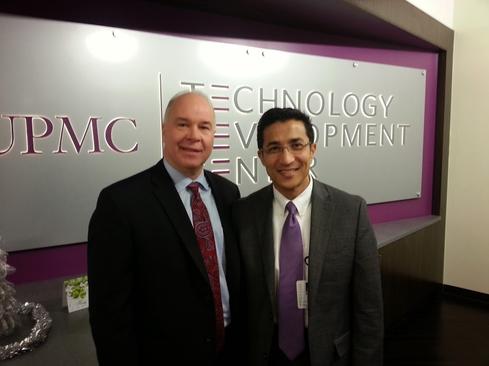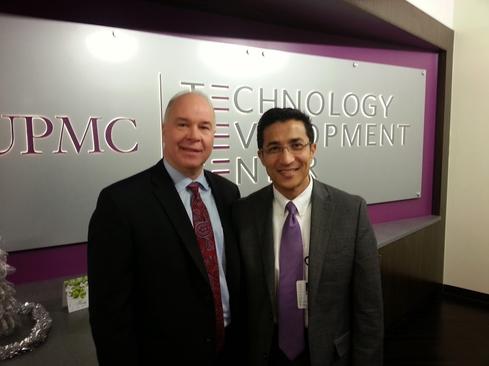Long a pioneer in adopting electronic medical records, the University of Pittsburgh Medical Center is on the verge of making them work together in new ways.


CES 2015 Preview: 8 Hot Trends
CES 2015 Preview: 8 Hot Trends (Click image for larger view and slideshow.)
The University of Pittsburgh Medical Center's commitment to a high-profile, sometimes-for-profit healthcare IT development center came into question last summer when the top two executives involved in the venture left. But UPMC's new technology leaders say the organization's ambitions haven't changed. If anything, they've grown bigger.
After 18 years as CIO of UPMC, and five years of nurturing its incubator-like Technology Development Center, Dan Drawbaugh decided last August to leave the healthcare system to "pursue other professional interests." At about the same time, Rebecca Kaul, who as president of the TDC articulated the organization's innovation strategy, also left UPMC. Their departures were unrelated and voluntary, according to UPMC. Even so, it was hard not to question whether they would mark a shift in strategy and perhaps a retreat from the notion that UPMC would invent healthcare technologies and bring them to market in addition to taking advantage of them in its clinical and operational work.
Based on a recent tour of the TDC and other outposts of innovation within UPMC, all systems indeed seem go. The conglomerate of hospitals, physician practices, and health plans that grew up around the University of Pittsburgh Medical Center still sees an opportunity to move beyond the current fragmented state of healthcare IT to more-coordinated, efficient, and humane systems, according to its leaders.
[Will health gadgets really work? Read Event-Driven Medicine Holds Great Promise.]
"It's not about incremental change," says Dr. Rasu Shrestha, the new president of the TDC as well as UPMC's chief innovation officer. "We're saying, let's move things to the next level -- where healthcare really needs to go." The federal Meaningful Use initiatives propelling adoption of health IT have tended to reinforce the digitization of paper processes, rather than force a rethinking and reinvention of them, he says. Digitizing medical records is only a first step.
Holding court in a conference room at the TDC, Shrestha and new CIO Ed McCallister professed to be "joined at the hip" in their pursuit of health IT advances. McCallister previously was CIO of UPMC's health insurance division, while Shrestha was VP of medical information technology, with a specialty in radiology informatics.
UPMC innovations often are developed in response to practical needs within the health system and tested within its clinical and insurance operations. If successful, they might graduate to broader deployment within UPMC and, sometimes, to commercialization. "If there's a challenge out there in healthcare, we've identified it -- for better or worse," McCallister says.
That's partly a factor of scale. UPMC is the largest non-governmental employer in Pennsylvania, with more than 62,000 employees. Although the TDC is a separate operation, its IT staffers have an opportunity to contribute their ideas and participate in new initiatives, the two men said. "One of the things we want to do is make sure innovation is seen as ordinary," not a separate activity, Shrestha says.
Figure 1:  UPMC CIO Ed McCallister and Chief Innovation Officer Dr. Rasu Shrestha
UPMC CIO Ed McCallister and Chief Innovation Officer Dr. Rasu Shrestha
The TDC currently has about 200 employees working on UPMC's own projects as well as joint ventures with GE Healthcare, Microsoft, Nuance, and Optum. The plan is to grow the staff to about 250 people in 2015, "and then we'll take a deep breath" to reevaluate progress, Shrestha says.
UPMC is affiliated with, but not owned by, the University of Pittsburgh. For technology talent, it can also draw on tech powerhouse Carnegie Mellon. Despite its Rust Belt reputation, Pittsburgh is in the midst of a revival, and Shrestha talks about wanting to play a role in its transformation into a hotbed of "eds and meds" technology. The TDC occupies a floor of the Bakery Square complex, a former Nabisco factory building where Google also has an office. Shrestha jokes that Google located nearby "to try to emulate some of our
success." The hallways are named after Pittsburgh streets, and some of the walls are covered with steel plates in honor of the city's industrial history.
As a complex organization -- a not-for-profit healthcare provider with for-profit subsidiaries and for-profit spinoffs emerging from the TDC -- UPMC attracts its share of criticism for its dominance. One recent controversy concerns UPMC's falling out with Highmark Blue Cross, which recently bought a competing hospital system, as UPMC forced people to choose between switching health plans or hospitals. UPMC maintains it's simply responding to competitive changes, as the lines between healthcare payers and providers continue to blur.
The Affordable Care Act also tends to encourage the creation of integrated payer-provider networks, changing the dynamics of competition. Some of UPMC's technology projects are aimed squarely at getting a better understanding of healthcare costs and managing them better, through better coordination of the payer and provider functions and integration of data from both sides.
A recent reorganization has broken down other walls within the organization, putting hospitals and UPMC-owned physician practices under common management in the new Health Services Division, where previously hospitals were managed separately.
With this push for organizational integration comes technological complexity. UPMC was an early adopter of electronic medical record systems, but it never standardized on a single EMR vendor. Cerner is its main inpatient hospital EMR, but UPMC uses Epic for outpatient operations, and several other systems are in the mix. Partly because of its need to integrate data from multiple EMRs, UPMC became an early investor in dbMotion, the health information exchange middleware company that is now part of Allscripts. (Although the terms EMR and EHR are often used interchangeably, by definition an EHR is supposed to be a comprehensive record -- so if that exists at UPMC, it would have to be through the unification of multiple EMRs.)
Yet Shrestha says UPMC's best-of-breed approach to EMR technology is a blessing in disguise. "That diverse platform is an advantage when it comes to innovation," he says, by giving TDC staffers an opportunity to test technology products against multiple EMRs and related software products.
'No way through other than succeeding'
Later that day in a separate interview, Annerose Berndt, VP of analytics and information for UPMC, rolled her eyes at the notion of diverse data sources being a positive. "Who told you that?" she asked, because it's her job to merge data from multiple sources and derive useful clinical and operational intelligence from it. "dbMotion was supposed to do it, but it doesn't really," she lamented. As someone trying to integrate more exotic data, such as genomic information, for better clinical decision support, the minutiae of reconciling data from multiple EMRs are a pure annoyance. Regardless, she's determined, saying that for the big data breakthroughs she wants to achieve, "there is no way through other than succeeding."
UPMC has taken a different approach to data integration with another TDC project, slated to launch as a spinoff company called Fluence at the upcoming HIMSS healthcare IT conference in April. The new firm will be built around the Windows tablet app that UPMC demonstrated at HIMSSlast year under the name Convergence, because it brings together data from multiple sources. Fluence is an example of what Shrestha meant when he spoke of making a virtue of UPMC's data source diversity; the system creates an "agnostic" view of health data drawn from four different EMRs and presents it in a unified user interface. For the data-integration piece, UPMC worked with Caradigm, a joint venture of GE and Microsoft, and got additional help from Intel.
The idea behind Fluence is to unify data around the tasks clinicians need to perform during a patient visit, while also suggesting pathways for appropriate care of that individual. "We are trying to make it easier for clinicians to do more of the right things," Shrestha says.
Fluence functions something like a data analytics portal -- although Windows-based rather than Web-based -- with hooks into the underlying systems for single sign-on. Clinicians use the app mainly to explore
information about the patient, but then to take action then can toggle into the underlying systems -- for example, by accessing the ePrescribing module of Cerner's EMR without the need to enter another password. One important aspect of this integration is that it preserves context, pulling up the record for the appropriate patient as the user toggles from one application to another, bypassing login screens and layers of menus.
At least that's how it works in the demos. UPMC currently has 75 or so active users of the system, which it initially piloted in its cardiology department and is expanding for use by hospitalists.
"Our clinicians are asking us for stuff all the time," says Vivek Reddy, chief medical information officer of UPMC's Health Services Division. Doctors' frustration with EMRs has given them an unfair reputation as Luddites, Reddy says, when really their frustration is that EMRs replicate paper processes that were broken to begin with. Instead of merely hustling to keep up with government regulation, the thrust should be "let's actually do something interesting," he says.
Apps such as Fluence are at least beginning to get at "what we always wanted and what we always thought the EMR would eventually do," Reddy says. Left to their own devices, EMR vendors treat innovation as a matter of adding a button here or a button there, he says. Rather than having to dig through screens and tabs of information, clinicians want software to "highlight things that need attention and bring them to the forefront."
Mining ailment combinations
Elsewhere, UPMC has started a venture called Evolvent, which it cofounded with the Advisory Board Company, aimed at perfecting the business model of an integrated health system and the preventative care discipline for controlling costs known as population health management.
Another new venture UPMC is involved in, Health Fidelity, emphasizes the use of natural language processing software to sift important details out of unstructured medical records such as physician notes. Health Fidelity was an independently formed Silicon Valley startup, but UPMC came in as its biggest investor and helped recruit its CEO. Health Fidelity already had an initial product under development, but with UPMC's help is preparing for a bigger push to commercialize it.
The goal of Health Fidelity's data mining is to identify what in Medicare lingo is known as Hierarchical Condition Categories, or combinations of ailments that can be used to identify high-risk patients. By identifying them, "we can focus on that person" and prevent their conditions from getting worse, Shrestha says. Health Fidelity is an example of automation simplifying what had been a labor-intensive process; UPMC was already sending people to doctors' offices to try to identify those high-risk patients, he says. "We thought we were doing a great job until we saw what was possible," Shrestha says.
A parallel effort for inpatient care is UPMC's clinical document improvement initiative, aimed at improving the structured data available for analysis and quality reporting, as well as accurate insurance coding so UPMC can get reimbursed properly for all the care it delivers. Here, the emphasis is on combing through EMR data to find records that are incomplete.
For example, a patient record might show a high body mass index without that patient having been specifically coded as being obese. A nurse reviewing the record can query the doctor electronically and get him to confirm -- with a click of a button or two -- that the record should indeed be coded as suggested. UPMC said the result has been at least a $32 million boost in money collected for its services.
Through a joint venture with GE Healthcare, UPMC is working on a next-generation digital medical imaging system that also integrates the process of ordering radiology studies and documenting the reason for them. The imaging desktop software addresses a range of specialties, including radiology, cardiology, and pathology, as well as support functions such as IT and scheduling.
One goal is to reduce the number of unnecessary images produced -- and doses of radiation delivered to patients in the process -- by eliminating duplication and making sure everyone has an incentive to improve health outcomes rather than just accumulate more images. On a technical level, GE and UPMC are trying to simplify the storage and organization of those images with a vendor-neutral architecture. The development team consists of 40 people in Pittsburgh, half from UPMC and half from GE, backed up by another 300 GE Healthcare employees.
Yet another branch of UPMC technology investment is focused not on the hospital or the doctor's office but on remote care. Although telemedicine experiments have been going on for a long time now, UPMC sees the potential for broader consumer adoption as mobile technology allows video consultations and secure messaging from a smartphone or tablet. It could help get people with non-emergency conditions out of the emergency room. As chief medical officer Reddy puts it, the vast majority of patient ER visits boil down to a simple question: Is this serious or not? Often, answering that question doesn't require an in-person visit.
"I dream of a day when 85% to 90% of healthcare isn't done inside of a healthcare place," Reddy says. "That's scary to some people, but I don't understand why it's not already like that." In no other part of our lives but healthcare, he says, does technology move so slowly.
UPMC says it's dedicated to making it move faster.
Apply now for the 2015 InformationWeek Elite 100, which recognizes the most innovative users of technology to advance a company's business goals. Winners will be recognized at the InformationWeek Conference, April 27-28, 2015, at the Mandalay Bay in Las Vegas. Application period ends Jan. 16, 2015.
About the Author(s)
You May Also Like







